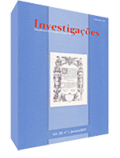Engajamento sartreano e mímesis na Literatura: pontos e contrapontos
Abstract
Este ensaio problematiza a consideração do filósofo Jean-Paul Sartre de que a literatura é a rigor “comprometida”. Para ele, escritor e sociedade se entrelaçam formando um elo refletido na literatura. Vendo a prosa como utilitária por essência, em que as palavras são instrumentos convencionais destinados a significar — tanto significar quanto falar, para Sartre, são agir. Assim, a palavra para o escritor “engajado” relaciona-se à mudança, à revelação.
References
BAKTHIN, Mikhail. 1998. Questões de Literatura e Estética — A teoria do Romance. São Paulo: Editora Unesp.
COMPAGNON, Antoine. 2001. O Mundo. In: — O demônio da teoria: literatura e senso comum. Belo Horizonte: UFMG, pp. 97-138.
ISER, Wolfang. 1996. O Ato da Leitura — Uma Teoria do Efeito
Estético. Trad. Johannes Kretschmer. São Paulo: Editora 34, vol.1.
JAUSS, Hans Robert. 1994. A história da literatura como provocação à teoria literéria. Trad. Sérgio Tellaroli. São Paulo: Editora Ática.
LIMA, Luiz Costa. 2000. Mímesis: desafio ao pensamento. Rio de
Janeiro: Civilização Brasileira.
______. 1980. Mímesis e modernidade: formas das sombras. Rio de
Janeiro: Edições Graal.
______. 1981. Representação social e mímesis. In: — Dispersa demanda. Rio de Janeiro: Francisco Alves, pp. 217-233.
SARTRE, Jean-Paul. 1993. Que é a Literatura? São Paulo: Ática.
Downloads
Published
How to Cite
Issue
Section
License
Copyright (c) 2007 Fabiana Ferreira da Costa

This work is licensed under a Creative Commons Attribution 4.0 International License.
Authors who publish with Revista Investigações agree to the following terms:
Authors retain copyright and grant the journal right of first publication with the work simultaneously licensed under the Creative Commons Attribution 4.0 International (CC BY 4.0) license that allows others to share the work with an acknowledgement of the work's authorship and initial publication in this journal.
Authors are able to enter into separate, additional contractual arrangements for the non-exclusive distribution of the journal's published version of the work (e.g., post it to an institutional repository or publish it in a book), with an acknowledgement of its initial publication in this journal.
You are free to:
Share — copy and redistribute the material in any medium or format for any purpose, even commercially.
Adapt — remix, transform, and build upon the material for any purpose, even commercially.
The licensor cannot revoke these freedoms as long as you follow the license terms.
Under the following terms:
Attribution — You must give appropriate credit , provide a link to the license, and indicate if changes were made . You may do so in any reasonable manner, but not in any way that suggests the licensor endorses you or your use.
No additional restrictions — You may not apply legal terms or technological measures that legally restrict others from doing anything the license permits.

